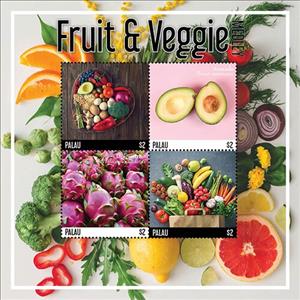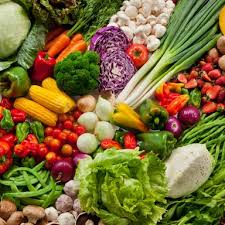Mini Sheet: Fruits and Vegetables (Palau 2020)
Fruits and Vegetables (Palau 2020)
15 June (Palau ) within release Fruits and Vegetables (2020) goes into circulation Mini Sheet Fruits and Vegetables face value 8 United States dollar
| Mini Sheet Fruits and Vegetables in catalogues | |
|---|---|
| Colnect codes: | Col: PW 2020-01MS |
Mini Sheet is square format.
Also in the issue Fruits and Vegetables (2020):
- Mini Sheet - Fruits and Vegetables face value 8;
- Souvenir Sheet - Pineapples face value 6;
- Stamp - Avocado (Persea americana) face value 2;
- Stamp - Fruits and Vegetables face value 2;
- Stamp - Fruits and Vegetables face value 2;
- Stamp - Hylocereus undatus face value 2;
- Stamp - Pineapple face value 3;
- Stamp - Pineapple face value 3;
Mini Sheet Fruits and Vegetables it reflects the thematic directions:
In botany, a fruit is the seed-bearing structure in flowering plants (also known as angiosperms) formed from the ovary after flowering. Fruits are the means by which angiosperms disseminate seeds. Edible fruits, in particular, have propagated with the movements of humans and animals in a symbiotic relationship as a means for seed dispersal and nutrition; in fact, humans and many animals have become dependent on fruits as a source of food. Accordingly, fruits account for a substantial fraction of the world's agricultural output, and some (such as the apple and the pomegranate) have acquired extensive cultural and symbolic meanings. In common language usage, "fruit" normally means the fleshy seed-associated structures of a plant that are sweet or sour, and edible in the raw state, such as apples, bananas, grapes, lemons, oranges, and strawberries. On the other hand, in botanical usage, "fruit" includes many structures that are not commonly called "fruits", such as bean pods, corn kernels, tomatoes, and wheat grains. The section of a fungus that produces spores is also called a fruiting body.
Flora is the plant life occurring in a particular region or time, generally the naturally occurring or indigenous—native plant life. The corresponding term for animal life is fauna. Flora, fauna and other forms of life such as fungi are collectively referred to as biota. Sometimes bacteria and fungi are also referred to as flora, as in the terms gut flora or skin flora.
Vegetables are parts of plants that are consumed by humans or other animals as food. The original meaning is still commonly used and is applied to plants collectively to refer to all edible plant matter, including the flowers, fruits, stems, leaves, roots, and seeds. An alternative definition of the term is applied somewhat arbitrarily, often by culinary and cultural tradition. It may exclude foods derived from some plants that are fruits, flowers, nuts, and cereal grains, but include savoury fruits such as tomatoes and courgettes, flowers such as broccoli, and seeds such as pulses.



